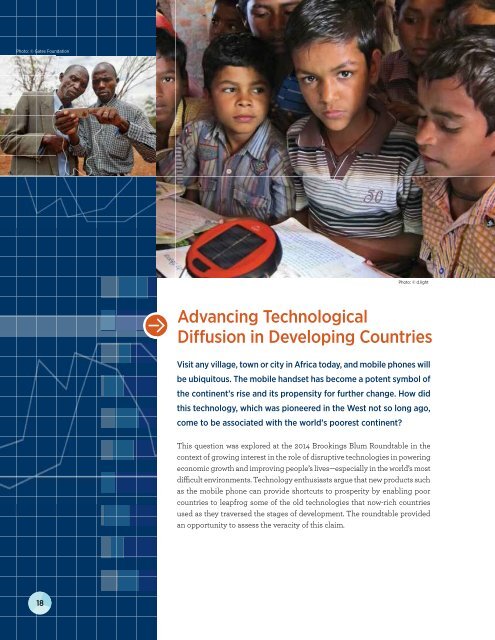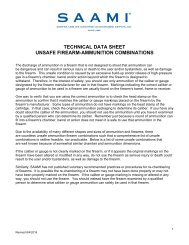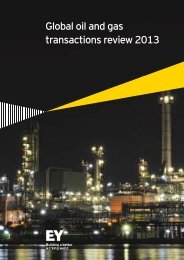Advancing Technological Diffusion in Developing Countries
Aspen14_Brookings_Blum_Roundtable_Technology
Aspen14_Brookings_Blum_Roundtable_Technology
You also want an ePaper? Increase the reach of your titles
YUMPU automatically turns print PDFs into web optimized ePapers that Google loves.
Photo: © Gates Foundation<br />
Photo: © d.light<br />
<strong>Advanc<strong>in</strong>g</strong> <strong>Technological</strong><br />
<strong>Diffusion</strong> <strong>in</strong> Develop<strong>in</strong>g <strong>Countries</strong><br />
Visit any village, town or city <strong>in</strong> Africa today, and mobile phones will<br />
be ubiquitous. The mobile handset has become a potent symbol of<br />
the cont<strong>in</strong>ent’s rise and its propensity for further change. How did<br />
this technology, which was pioneered <strong>in</strong> the West not so long ago,<br />
come to be associated with the world’s poorest cont<strong>in</strong>ent?<br />
This question was explored at the 2014 Brook<strong>in</strong>gs Blum Roundtable <strong>in</strong> the<br />
context of grow<strong>in</strong>g <strong>in</strong>terest <strong>in</strong> the role of disruptive technologies <strong>in</strong> power<strong>in</strong>g<br />
economic growth and improv<strong>in</strong>g people’s lives—especially <strong>in</strong> the world’s most<br />
difficult environments. Technology enthusiasts argue that new products such<br />
as the mobile phone can provide shortcuts to prosperity by enabl<strong>in</strong>g poor<br />
countries to leapfrog some of the old technologies that now-rich countries<br />
used as they traversed the stages of development. The roundtable provided<br />
an opportunity to assess the veracity of this claim.<br />
18
Photo: © Gates Foundation<br />
TECHNOLOGY, GROWTH, CONVERGENCE<br />
AND GLOBALIZATION<br />
The spread of technology is one of the central<br />
ideas underp<strong>in</strong>n<strong>in</strong>g growth theory <strong>in</strong> economics.<br />
Rich countries are positioned at the technology<br />
frontier—mean<strong>in</strong>g that their economies make<br />
virtually full use of the best available devices,<br />
practices, ideas and know-how to generate their<br />
output. For these countries, marg<strong>in</strong>al productivity<br />
ga<strong>in</strong>s depend on the discovery of new technologies<br />
that push the technology frontier further out. In<br />
contrast, poorer countries are positioned some<br />
distance back from this frontier. Poor countries’<br />
opportunity to make use of proven technologies<br />
without hav<strong>in</strong>g to develop them from scratch is<br />
one factor that allows them to grow faster than rich<br />
countries under the right conditions, and thereby<br />
accelerate closer to the frontier.<br />
Globalization acts as a catalyst for this phenomenon.<br />
Dur<strong>in</strong>g the last two decades, the boom<br />
<strong>in</strong> global trade driven by the conta<strong>in</strong>erization of<br />
traded goods and the elim<strong>in</strong>ation of tariffs and other<br />
barriers, cheaper communication made possible<br />
through <strong>in</strong>formation technology, and a dramatic<br />
expansion <strong>in</strong> foreign direct <strong>in</strong>vestment have all<br />
likely played a role <strong>in</strong> accelerat<strong>in</strong>g the diffusion of<br />
technology from rich to poor countries. This period<br />
of “hyperglobalization,” dur<strong>in</strong>g which the growth<br />
rate of global trade volumes has far exceeded that<br />
of the global economy, has seen three times the<br />
number of develop<strong>in</strong>g economies converg<strong>in</strong>g on<br />
the rich world’s liv<strong>in</strong>g standards and at an average<br />
of twice the speed of the preced<strong>in</strong>g era. 1<br />
At the roundtable, participants were furnished<br />
with evidence show<strong>in</strong>g how adoption lags between<br />
developed and develop<strong>in</strong>g countries have <strong>in</strong>deed<br />
narrowed dramatically—and thus, new technologies<br />
forged <strong>in</strong> Silicon Valley today can f<strong>in</strong>d their<br />
way to the shores of develop<strong>in</strong>g countries with<strong>in</strong><br />
a negligible time frame. 2<br />
CIRCUMVENTING MARKET AND<br />
GOVERNMENT FAILURES<br />
The idea that poor countries can borrow the rich<br />
world’s technologies and thereby catch up with<br />
its liv<strong>in</strong>g standards is an attractive proposition on<br />
its own. But an additional aspect of leapfrogg<strong>in</strong>g<br />
makes it especially seductive: Leapfrogg<strong>in</strong>g enables<br />
develop<strong>in</strong>g countries to leave beh<strong>in</strong>d yesterday’s<br />
technologies, whose provision is encumbered by<br />
market and government failures, and to replace<br />
them with a new set of disruptive frontier technologies<br />
that are seem<strong>in</strong>gly less vulnerable to<br />
these effects.<br />
To demonstrate this argument, let us return<br />
to the example of mobile phones. To understand<br />
the transformative impact of this technology <strong>in</strong><br />
the world’s poorest countries, it is crucial to first<br />
1. Arv<strong>in</strong>d Subramanian and Mart<strong>in</strong> Kessler, The Hyperglobalization of<br />
Trade and Its Future, Work<strong>in</strong>g Paper 13-6 (Wash<strong>in</strong>gton: Peterson<br />
Institute for International Economics, 2013), http://www.iie.com/<br />
publications/wp/wp13-6.pdf.<br />
2. Diego Com<strong>in</strong>, “The Evolution of Technology <strong>Diffusion</strong> and the Great<br />
Divergence,” paper for 2014 Brook<strong>in</strong>gs Blum Roundtable, http://www.<br />
brook<strong>in</strong>gs.edu/~/media/Programs/global/bbr2014/Session%203%20<br />
%20Leapfrogg<strong>in</strong>g%20%20Com<strong>in</strong>_FINAL.pdf.<br />
19
The critical question is what factors<br />
will enable new technologies to succeed<br />
where others fail. Understand<strong>in</strong>g<br />
these factors can help <strong>in</strong> identify<strong>in</strong>g<br />
the role of the development community<br />
<strong>in</strong> support<strong>in</strong>g leapfrogg<strong>in</strong>g.<br />
Photo: © Gates Foundation<br />
note the dismal performance of the preced<strong>in</strong>g<br />
technology, the landl<strong>in</strong>e telephone, <strong>in</strong> these<br />
countries. The sad fate of landl<strong>in</strong>es is expla<strong>in</strong>ed by<br />
the characteristics of the technology it employs.<br />
Landl<strong>in</strong>e <strong>in</strong>frastructure exhibits some of the characteristics<br />
of a public good and is a natural monopoly<br />
with especially high fixed costs. Therefore, it has<br />
typically been provided by the state and has been<br />
underprovided <strong>in</strong> low-<strong>in</strong>come, poorly governed<br />
countries. Mobile phone <strong>in</strong>frastructure has some<br />
of these same characteristics, but to a much lesser<br />
degree. The result is that the quality and coverage<br />
of mobile phone services are far superior to landl<strong>in</strong>e<br />
services <strong>in</strong> virtually all develop<strong>in</strong>g countries.<br />
As a general rule, the worse the provision of an<br />
<strong>in</strong>cumbent technology, the greater the attraction<br />
of new technologies that can replace it. This has<br />
been demonstrated <strong>in</strong> the well-documented rise of<br />
the Kenyan mobile money service M-PESA. One of<br />
the factors to which M-PESA’s <strong>in</strong>itial success was<br />
attributed was the woeful provision of brick-andmortar<br />
bank<strong>in</strong>g and domestic remittance services<br />
to the general populace before M-PESA’s launch.<br />
Another factor was the soft regulatory environment<br />
that allowed M-PESA to establish itself as<br />
a competitor with the traditional bank<strong>in</strong>g sector.<br />
That same regulatory environment was regularly<br />
criticized before the disruption of mobile phones<br />
and mobile money, when both the bank<strong>in</strong>g and<br />
communications <strong>in</strong>dustries saw little competition,<br />
generated large rents and made m<strong>in</strong>imal effort to<br />
serve low-<strong>in</strong>come customers. Thus, the perception<br />
of Kenya’s regulatory regime reversed from vice<br />
to virtue.<br />
ASSESSING THE PIPELINE<br />
At the roundtable, participants had a chance to<br />
hear from lead<strong>in</strong>g entrepreneurs and th<strong>in</strong>kers<br />
who are seek<strong>in</strong>g to develop and market the next<br />
generation of leapfrogg<strong>in</strong>g technologies. These<br />
technologies are at various stages <strong>in</strong> the pipel<strong>in</strong>e,<br />
rang<strong>in</strong>g from proven technologies that are <strong>in</strong> the<br />
process of be<strong>in</strong>g scaled up <strong>in</strong> the develop<strong>in</strong>g world<br />
to those that are still be<strong>in</strong>g ref<strong>in</strong>ed.<br />
After many false starts, the latest range of<br />
off-grid solar power solutions are br<strong>in</strong>g<strong>in</strong>g energy<br />
access to tens of millions of households <strong>in</strong> Africa<br />
and South Asia. A comb<strong>in</strong>ation of lower costs,<br />
better f<strong>in</strong>anc<strong>in</strong>g options and more durable and<br />
varied products has spawned a number of viable<br />
bus<strong>in</strong>ess models, whose success has prompted<br />
the U.S. government to <strong>in</strong>crease by threefold the<br />
targets for its flagship Power Africa project.<br />
The grow<strong>in</strong>g ranks of the middle class,<br />
comb<strong>in</strong>ed with ris<strong>in</strong>g Internet connectivity and<br />
more affordable smartphones, have prompted<br />
<strong>in</strong>creas<strong>in</strong>g <strong>in</strong>terest <strong>in</strong> e-commerce <strong>in</strong> several African<br />
economies. Nigeria has been lead<strong>in</strong>g this charge<br />
by establish<strong>in</strong>g a number of new platforms that<br />
allow third-party retail<strong>in</strong>g, follow<strong>in</strong>g the model<br />
of Amazon.com. The country’s weak physical<br />
20
<strong>in</strong>frastructure and the poor quality of its brick-andmortar<br />
stores have been cited as catalytic factors<br />
<strong>in</strong> these platforms’ early success. 3<br />
Among the technologies discussed at the<br />
roundtable that are still <strong>in</strong> earlier phases of<br />
development and adoption <strong>in</strong> the develop<strong>in</strong>g world<br />
are massive open onl<strong>in</strong>e courses that promise to<br />
deliver high-quality, tertiary education around<br />
the world at a marg<strong>in</strong>al price close to zero; digital<br />
libraries for schools that are connected to low-cost,<br />
free-stand<strong>in</strong>g onl<strong>in</strong>e servers; and computer labs, <strong>in</strong><br />
Haiti and elsewhere, employ<strong>in</strong>g tablet computers<br />
that are easy for those less familiar with IT systems<br />
to master. Several stages further back from<br />
commercial read<strong>in</strong>ess are the use of drones for<br />
commercial transportation, <strong>in</strong>clud<strong>in</strong>g heavy cargo.<br />
Each of these leapfrogg<strong>in</strong>g technologies has<br />
both its enthusiasts and its skeptics. The critical<br />
question is what factors will enable some to succeed<br />
where others fail. Understand<strong>in</strong>g these factors can<br />
help <strong>in</strong> identify<strong>in</strong>g the role of the development<br />
community <strong>in</strong> support<strong>in</strong>g leapfrogg<strong>in</strong>g.<br />
SUCCESS FACTORS<br />
The <strong>in</strong>creas<strong>in</strong>g speed with which new technologies<br />
gravitate toward develop<strong>in</strong>g countries is<br />
a welcome phenomenon. But access to these<br />
technologies offers no guarantee that they will be<br />
broadly adopted and applied to their full range of<br />
possible uses. Indeed the evidence of technology<br />
adoption rates <strong>in</strong> poor countries is chasten<strong>in</strong>g.<br />
Once technologies establish a foothold <strong>in</strong> the<br />
markets of <strong>in</strong>dustrialized countries, it is virtually<br />
certa<strong>in</strong> that they will spread widely with<strong>in</strong> these<br />
countries. But <strong>in</strong> develop<strong>in</strong>g countries, technologies<br />
are very rarely adopted on a large enough scale<br />
to ensure genu<strong>in</strong>e leapfrogg<strong>in</strong>g. On this measure,<br />
the difference between develop<strong>in</strong>g and developed<br />
economies appears to be widen<strong>in</strong>g.<br />
The roundtable discussion honed <strong>in</strong> on two<br />
issues that can expla<strong>in</strong> why new technologies only<br />
rarely achieve widespread adoption <strong>in</strong> develop<strong>in</strong>g<br />
countries. The first is <strong>in</strong>sufficient knowledge, both<br />
tacit and explicit, of the k<strong>in</strong>d that is required to<br />
employ, adapt and <strong>in</strong>corporate new technologies<br />
<strong>in</strong>to bus<strong>in</strong>ess practices and people’s daily lives.<br />
This knowledge is important both for the designers,<br />
eng<strong>in</strong>eers and entrepreneurs who seek to market<br />
new technologies <strong>in</strong> develop<strong>in</strong>g countries and also<br />
for the end users whose adoption of the technology<br />
is the ultimate gauge of success. The roundtable<br />
participants heard first-hand accounts of the hard<br />
work <strong>in</strong>volved <strong>in</strong> persuad<strong>in</strong>g consumers and other<br />
users to recognize the benefits of new technologies.<br />
Acknowledg<strong>in</strong>g the importance of such knowledge<br />
highlights the complexity of leapfrogg<strong>in</strong>g<br />
and upends the simplistic narrative of the so-called<br />
advantage of backwardness. An economy is more<br />
capable of master<strong>in</strong>g a new technology if it has<br />
already demonstrated its command of a preced<strong>in</strong>g,<br />
similar technology. Thus, while a failure to<br />
successfully employ old technologies may make<br />
the <strong>in</strong>troduction of new technologies especially<br />
transformative, as was the case with the mobile<br />
3. Xan Rice, “Internet Sales Flourish <strong>in</strong> Nigeria,” F<strong>in</strong>ancial Times, http://<br />
www.ft.com/<strong>in</strong>tl/cms/s/0/3f455b7e-b1bb-11e2-9315-00144feabdc0.<br />
html#axzz3I8UZLzSa.<br />
21
FIGURE 1. TECH HUBS ACROSS AFRICA<br />
TECH HUBS ACROSS AFRICA<br />
(as of February 2014)<br />
TECH HUBS ACROSS AFRICA<br />
ECONOMIES WITH A KNOWN TECH HUB<br />
INTERNATIONAL BOUNDARIES<br />
Source: iHub Research / World Bank / Bongohive<br />
(as of June 2014) Source: iHub Research/World Bank/Bongohive<br />
(as of February 2014)<br />
ECONOMIES WITH WITH A KNOWN A KNOWN TECH HUBTECH HUB<br />
INTERNATIONAL BOUNDARIES BOUNDARIES<br />
Source: iHub Research / World Bank / Bongohive<br />
IBRD 40702<br />
MOROCCO<br />
Al Akhawayn University Technology<br />
Bus<strong>in</strong>ess <strong>in</strong>cubator<br />
MOROCCO<br />
Al<br />
Al<br />
Akhawayn<br />
Akhawayn<br />
University<br />
University<br />
Technology<br />
Technology<br />
Bus<strong>in</strong>ess<br />
Bus<strong>in</strong>ess<br />
<strong>in</strong>cubator<br />
<strong>in</strong>cubator<br />
TUNISIA<br />
Wiki Start Up<br />
Mediterranean Sea<br />
TUNISIA<br />
Wiki<br />
Wiki<br />
Start<br />
Start<br />
Up<br />
Up<br />
Mediterranean<br />
Mediterranean<br />
Sea<br />
Sea<br />
SENEGAL<br />
Jokkolabs<br />
Bantalabs<br />
CTIC Dakar<br />
Africa Liv<strong>in</strong>g Lab<br />
Mobile Senegal<br />
Jiguene Tech Hub<br />
LIBERIA<br />
iLab Liberia<br />
CÔTE D’IVOIRE<br />
ICT Incubator<br />
Jokkolabs Abidjan<br />
Akendewa<br />
AMN Co-work<strong>in</strong>g Space<br />
Waleya Tech hub<br />
ATLANTIC OCEAN<br />
MALI<br />
Jokkolabs Bamako<br />
SENEGAL<br />
Jokkolabs<br />
Jokkolabs<br />
Bantalabs<br />
Bantalabs<br />
BURKINA CTIC<br />
CTIC<br />
Dakar<br />
Dakar FASO<br />
Africa<br />
Africa<br />
Liv<strong>in</strong>g<br />
Liv<strong>in</strong>g Yam Lab<br />
Lab Pukri<br />
Jokkolabs Mobile<br />
Mobile Ouagadougou Senegal<br />
Senegal<br />
Jiguene<br />
Jiguene<br />
Tech<br />
Tech<br />
Hub<br />
Hub<br />
GHANA<br />
mFriday<br />
MEST<br />
Afr<strong>in</strong>nova<br />
gSpace<br />
iSpace<br />
Ghana Multimedia<br />
Incubator Centre<br />
Mobile Web<br />
Ghana<br />
Kumasi Bus<strong>in</strong>ess<br />
Incubator<br />
Oguaa Bus<strong>in</strong>ess<br />
Incubator<br />
TOGO<br />
The Labs<br />
NIGERIA<br />
L5 Labs<br />
Co-creation Hub<br />
Wennovation Hub<br />
Technology Incubation Centre<br />
M<strong>in</strong>na Tech Incubation Centre<br />
Institute for Venture Design<br />
T<strong>in</strong>apa Knowledge Centre<br />
Focus Hub<br />
Enspire Incubator<br />
LIBERIA<br />
BENIN<br />
iLab<br />
iLab<br />
Liberia<br />
Liberia<br />
e-TRILABS<br />
CÔTE D’IVOIRE<br />
ICT<br />
ICT<br />
Incubator<br />
Incubator<br />
Jokkolabs<br />
Jokkolabs<br />
Abidjan<br />
Abidjan<br />
Akendewa<br />
Akendewa<br />
AMN<br />
AMN<br />
Co-work<strong>in</strong>g<br />
Co-work<strong>in</strong>g<br />
Space<br />
Space<br />
Waleya<br />
Waleya<br />
Tech<br />
Tech<br />
hub<br />
hub<br />
ANGOLA<br />
INEEFP Bus<strong>in</strong>ess Incubator<br />
CAMEROON<br />
ActivSpaces<br />
Digitis<strong>in</strong>g Cameroon<br />
ATLANTIC OCEAN<br />
NAMIBIA<br />
Namibia Bus<strong>in</strong>ess Innovation Centre<br />
Fablab Namibia<br />
ARAB REP.<br />
OF EGYPT<br />
Cairo Hackspace<br />
Tahrir Square<br />
The District<br />
Flat6Labs<br />
Plug and Play Egypt<br />
MALI<br />
NIGERIA<br />
Jokkolabs<br />
Jokkolabs<br />
Bamako<br />
Bamako<br />
SOMALIA<br />
L5<br />
L5<br />
Labs<br />
Labs<br />
Somaliland BITS<br />
Co-creation<br />
Co-creation<br />
Hub<br />
Hub<br />
Wennovation<br />
Wennovation<br />
UGANDA Hub<br />
Hub<br />
Technology<br />
Technology<br />
Incubation<br />
Incubation<br />
@TheHub Centre<br />
Centre<br />
BURKINA FASO<br />
M<strong>in</strong>na<br />
M<strong>in</strong>na<br />
Tech<br />
Tech<br />
Incubation<br />
Incubation<br />
Outbox Centre<br />
Centre<br />
ETHIOPIA<br />
Yam<br />
Yam<br />
Pukri<br />
Pukri<br />
Institute<br />
Institute<br />
for<br />
for<br />
Venture<br />
Venture<br />
Hive Design<br />
Design<br />
Colab<br />
IceAddis<br />
UGANDA<br />
Jokkolabs<br />
Jokkolabs<br />
Ouagadougou<br />
Ouagadougou<br />
T<strong>in</strong>apa<br />
T<strong>in</strong>apa<br />
Knowledge<br />
Knowledge<br />
Grameen Centre<br />
Centre<br />
Mekelle ICT<br />
@TheHub<br />
@TheHub<br />
Foundation<br />
Focus<br />
Focus<br />
Hub<br />
Hub<br />
Bus<strong>in</strong>ess Incubator<br />
AppLab<br />
Outbox<br />
Outbox<br />
Enspire<br />
Enspire<br />
Incubator<br />
Incubator<br />
Hive<br />
Hive<br />
Colab<br />
Colab<br />
RWANDA<br />
Grameen<br />
Grameen<br />
kLab<br />
CAMEROON<br />
Foundation<br />
Foundation<br />
The Office<br />
ActivSpaces<br />
ActivSpaces<br />
AppLab<br />
AppLab<br />
KENYA<br />
iHills Network Digitis<strong>in</strong>g<br />
Digitis<strong>in</strong>g<br />
Cameroon<br />
Cameroon<br />
RWANDAiHub<br />
CONGO<br />
kLab<br />
kLab Aro Fab<br />
BantuL@b DEM. REP.<br />
The<br />
The<br />
Office<br />
Office m:Lab East Africa<br />
GHANA<br />
TOGO<br />
OF CONGO<br />
BENIN<br />
iHills<br />
iHills<br />
Network<br />
Network Start-up Garage<br />
mFriday<br />
mFriday<br />
The<br />
The<br />
Labs<br />
Labs<br />
e-TRILABS<br />
e-TRILABS<br />
Bantu l@b<br />
CONGO TANZANIA<br />
GrowthHub<br />
MEST<br />
MEST<br />
BantuL@b<br />
BantuL@b<br />
K<strong>in</strong>u<br />
DEM. REP.<br />
Nokia Hub<br />
Afr<strong>in</strong>nova<br />
Afr<strong>in</strong>nova<br />
Dar es Salaam Open<br />
OF CONGO @iLab Africa<br />
gSpace<br />
gSpace<br />
Knowledge Community<br />
Bantu<br />
Bantu<br />
l@b<br />
l@b<br />
NaiLab<br />
iSpace<br />
iSpace<br />
Innovation Space<br />
Ghana<br />
Ghana<br />
Multimedia<br />
Multimedia<br />
TANZICT<br />
Incubator<br />
Incubator<br />
Centre<br />
Centre<br />
Dar Tek<strong>in</strong>ohama Bus<strong>in</strong>ess<br />
Mobile<br />
Mobile<br />
Web<br />
Web<br />
Incubator<br />
Ghana<br />
Ghana<br />
Buni Hub<br />
Kumasi<br />
Kumasi<br />
Bus<strong>in</strong>ess<br />
Bus<strong>in</strong>ess<br />
Incubator<br />
Incubator<br />
Oguaa<br />
Oguaa<br />
Bus<strong>in</strong>ess<br />
Bus<strong>in</strong>ess<br />
ZAMBIA<br />
Incubator<br />
Incubator<br />
Workgroup<br />
Workgroup<br />
Innovation<br />
Innovation<br />
Centre<br />
Centre<br />
Bongohive<br />
Bongohive<br />
Zambia<br />
Zambia<br />
ZAMBIA<br />
Workgroup Innovation Centre<br />
Bongohive Zambia<br />
ANGOLA<br />
INEEFP<br />
INEEFP<br />
Bus<strong>in</strong>ess<br />
Bus<strong>in</strong>ess<br />
Incubator<br />
Incubator<br />
ZIMBABWE<br />
Ski Hub Initiative<br />
Hypercube Hub<br />
Muz<strong>in</strong>da Umuzi<br />
BOTSWANA<br />
Botswana Innovation Hub<br />
Chaetsho Technology Hub<br />
First Steps Venture Center<br />
Red Sea<br />
NAMIBIA<br />
Namibia<br />
Namibia<br />
Bus<strong>in</strong>ess<br />
Bus<strong>in</strong>ess<br />
Innovation<br />
Innovation<br />
Centre<br />
Centre<br />
Fablab<br />
Fablab<br />
Namibia<br />
Namibia<br />
SOUTH AFRICA<br />
Bandwidth Barn<br />
Umbono<br />
Silicon Cape<br />
Impact Amplifier<br />
Codebridge<br />
Angel Hub<br />
Eastern Cape Information<br />
Technology Initiative<br />
Smart Xchange<br />
Coded<strong>in</strong>Braam<br />
Innovation by Design<br />
SoftStart Technology<br />
The House 4 Hack<br />
mLab Southern Africa<br />
Start-up Garage<br />
The Hub<br />
Rlabs<br />
Invo Tech <strong>in</strong>cubator<br />
The Innovation Hub<br />
ARAB REP.<br />
OF EGYPT<br />
Cairo<br />
Cairo<br />
Hackspace<br />
Hackspace<br />
Tahrir<br />
Tahrir<br />
Square<br />
Square<br />
The<br />
The<br />
District<br />
District<br />
Flat6Labs<br />
Flat6Labs<br />
Plug<br />
Plug<br />
and<br />
and<br />
Play<br />
Play<br />
Egypt<br />
Egypt<br />
MOZAMBIQUE<br />
MICTI Technology and MADAGASCAR<br />
Bus<strong>in</strong>ess Centre<br />
ZIMBABWE<br />
I-Hub Malagasy<br />
Ski<br />
Ski<br />
Hub<br />
Hub<br />
Initiative<br />
Initiative<br />
Hypercube<br />
Hypercube<br />
Hub<br />
Hub<br />
Muz<strong>in</strong>da<br />
Muz<strong>in</strong>da<br />
Umuzi<br />
Umuzi<br />
BOTSWANA<br />
Botswana<br />
Botswana<br />
Innovation<br />
Innovation<br />
Hub<br />
Hub<br />
Chaetsho<br />
Chaetsho<br />
Technology<br />
Technology<br />
Hub<br />
Hub<br />
First<br />
First<br />
Steps<br />
Steps<br />
Venture<br />
Venture<br />
Center<br />
Center<br />
INDIAN OCEAN<br />
TANZANIA<br />
K<strong>in</strong>u<br />
K<strong>in</strong>u<br />
Dar<br />
Dar<br />
es<br />
es<br />
Salaam<br />
Salaam<br />
Open<br />
Open<br />
Knowledge<br />
Knowledge<br />
Community<br />
Community<br />
Innovation<br />
Innovation<br />
Space<br />
Space<br />
TANZICT<br />
TANZICT<br />
Dar<br />
Dar<br />
Tek<strong>in</strong>ohama<br />
Tek<strong>in</strong>ohama<br />
Bus<strong>in</strong>ess<br />
Bus<strong>in</strong>ess<br />
Incubator<br />
Incubator<br />
Buni<br />
Buni<br />
Hub<br />
Hub<br />
MAURITIUS<br />
Cybercity mLab<br />
SOUTH AFRICA<br />
Bandwidth<br />
Bandwidth<br />
Barn<br />
Barn<br />
Umbono<br />
Umbono<br />
Silicon<br />
Silicon<br />
Cape<br />
Cape<br />
Impact<br />
Impact<br />
Amplifier<br />
Amplifier<br />
Codebridge<br />
Codebridge<br />
Angel<br />
Angel<br />
Hub<br />
Hub<br />
0 500 1,000 Miles<br />
Eastern<br />
Eastern<br />
Cape<br />
Cape<br />
Information<br />
Information<br />
Technology<br />
Technology<br />
Initiative<br />
Initiative<br />
Smart<br />
Smart<br />
Xchange<br />
Xchange<br />
0 500 1,000 Kilometers<br />
0<br />
500<br />
500<br />
1,000<br />
1,000<br />
Miles<br />
Miles<br />
Coded<strong>in</strong>Braam<br />
Coded<strong>in</strong>Braam<br />
Innovation<br />
Innovation<br />
by<br />
by<br />
Design<br />
Design<br />
This map was produced by the Map Design Unit of The World Bank.<br />
SoftStart<br />
SoftStart<br />
Technology<br />
Technology<br />
The boundaries, colors, denom<strong>in</strong>ations 0<br />
and any other 500<br />
500<br />
<strong>in</strong>formation 1,000<br />
1,000<br />
Kilometers<br />
Kilometers<br />
The<br />
The<br />
House<br />
House 4<br />
Hack<br />
Hack<br />
shown on this map do not imply, on the part of The World Bank<br />
mLab<br />
mLab<br />
Southern<br />
Southern<br />
Africa<br />
Africa<br />
GSDPM Group, any judgment on the legal status of any territory, This or map anywas produced by the Map Design Unit of The World Bank.<br />
Start-up<br />
Start-up<br />
Garage<br />
Garage<br />
Map Design Unit endorsement or acceptance of such boundaries.<br />
This map was produced by the Map Design Unit of The World Bank.<br />
The boundaries, colors, denom<strong>in</strong>ations and any other <strong>in</strong>formation<br />
The boundaries, colors, denom<strong>in</strong>ations and any other <strong>in</strong>formation<br />
The<br />
The<br />
Hub<br />
Hub<br />
shown on this map do not imply, on the part of The World Bank<br />
shown on this map do not imply, on the part of The World Bank<br />
Rlabs<br />
Rlabs<br />
GSDPM Group, any judgment on the legal status of any territory, or any<br />
Group, any judgment on the legal status of any territory, or any<br />
Invo<br />
Invo<br />
Tech<br />
Tech<br />
<strong>in</strong>cubator<br />
<strong>in</strong>cubator<br />
Map Design Unit<br />
MAY 2014<br />
Map Design Unit endorsement acceptance of such boundaries.<br />
endorsement Source: or World acceptance Bank, of http://blogs.worldbank.org/ic4d/weve-updated-africa-tech-hub-map-us<strong>in</strong>g-your-suggestions.<br />
such boundaries.<br />
The<br />
The<br />
Innovation<br />
Innovation<br />
Hub<br />
Hub<br />
NAMIBIA<br />
Red Red Sea Sea<br />
ETHIOPIA<br />
IceAddis<br />
IceAddis<br />
Mekelle<br />
Mekelle<br />
ICT<br />
ICT<br />
Bus<strong>in</strong>ess<br />
Bus<strong>in</strong>ess<br />
Incubator<br />
Incubator<br />
MOZAMBIQUE<br />
MICTI<br />
MICTI<br />
Technology<br />
Technology<br />
and<br />
and<br />
Bus<strong>in</strong>ess<br />
Bus<strong>in</strong>ess<br />
Centre<br />
Centre<br />
SOMALIA<br />
Somaliland<br />
Somaliland B<br />
KEN<br />
iHub<br />
iHub<br />
Aro<br />
Aro<br />
Fa<br />
Fa<br />
m:Lab<br />
m:Lab<br />
Start-<br />
Start-<br />
Growt<br />
Growt<br />
Nokia<br />
Nokia<br />
@iLab<br />
@iLab<br />
NaiLa<br />
NaiLa<br />
MADAGASCAR<br />
I-Hub<br />
I-Hub<br />
Malagasy<br />
Malagasy<br />
INDIAN OCEA
Photo: © Syed Muhammad Rafiq for ADB<br />
phone, it also implies that the transition to new<br />
technologies will pose a bigger challenge for users.<br />
The leapfrogg<strong>in</strong>g technologies that have the best<br />
chance of be<strong>in</strong>g scaled up today are precisely those<br />
that seek to avoid the need to build on previously<br />
learned basics.<br />
A priority for poor countries is to <strong>in</strong>vest <strong>in</strong><br />
the right k<strong>in</strong>ds of knowledge so that imported<br />
technologies can be more effectively harnessed<br />
and adapted for productive use. But it is fiendishly<br />
hard to identify these k<strong>in</strong>ds of knowledge.<br />
In Africa <strong>in</strong> recent years, a popular approach<br />
to foster<strong>in</strong>g such knowledge has been to create<br />
technology hubs. These hubs provide environments<br />
where new bus<strong>in</strong>esses can be <strong>in</strong>cubated and<br />
commercial partners can be l<strong>in</strong>ked to designers<br />
and entrepreneurs. Figure 1 shows the location of<br />
over 100 hubs as of June 2014. But it rema<strong>in</strong>s to<br />
be seen if these hubs can succeed <strong>in</strong> foster<strong>in</strong>g a<br />
new culture of digital entrepreneurship and can<br />
adequately address the broader knowledge deficit<br />
that constra<strong>in</strong>s technological adoption.<br />
The second issue that expla<strong>in</strong>s the limited<br />
adoption of new technologies <strong>in</strong> develop<strong>in</strong>g<br />
countries is the broader ecosystem with<strong>in</strong> which<br />
the enterprises that market these technologies<br />
operate. An unsupportive ecosystem makes viable<br />
bus<strong>in</strong>ess models harder to identify, and makes<br />
scal<strong>in</strong>g up a more elusive goal.<br />
An ecosystem can be unpacked <strong>in</strong>to three parts:<br />
value cha<strong>in</strong>s, public goods, and policy and regulation.<br />
4 Weak value cha<strong>in</strong>s are a much-cited problem<br />
fac<strong>in</strong>g enterprises <strong>in</strong> poor economies. Common<br />
problems <strong>in</strong>clude unreliable or uncompetitive<br />
suppliers, which <strong>in</strong>crease costs for enterprises<br />
and their customers; limited f<strong>in</strong>anc<strong>in</strong>g along the<br />
value cha<strong>in</strong>, which creates bottlenecks; and the<br />
limited availability of high-quality professional<br />
services, such as those provided by accountants<br />
and lawyers. The weak provision of public goods,<br />
rang<strong>in</strong>g from power to ports, can easily cause prices<br />
to spiral out of control and underm<strong>in</strong>e bus<strong>in</strong>ess<br />
models. Quality standards, consumer education<br />
and market <strong>in</strong>formation are also often deficient<br />
<strong>in</strong> low-<strong>in</strong>come markets, and their public-good<br />
characteristics present obvious challenges for how<br />
their provision can be expanded and coord<strong>in</strong>ated.<br />
Constra<strong>in</strong><strong>in</strong>g, ambiguous or absent policies and<br />
regulations pose another obstacle for enterprises<br />
<strong>in</strong>troduc<strong>in</strong>g new technologies and add to <strong>in</strong>vestors’<br />
uncerta<strong>in</strong>ty.<br />
The entrepreneurs who participated <strong>in</strong> the<br />
roundtable stressed the importance of ecosystem<br />
factors <strong>in</strong> enabl<strong>in</strong>g the leapfrogg<strong>in</strong>g technologies<br />
that they are seek<strong>in</strong>g to propagate to succeed.<br />
Strik<strong>in</strong>gly, some stressed that they needed more<br />
entrants, or competitors, <strong>in</strong>to their market <strong>in</strong><br />
order to foster greater ecosystem effects. Others<br />
suggested that be<strong>in</strong>g too far out <strong>in</strong> front of the<br />
market posed excessive risks. Such arguments<br />
are unlikely to be heard among technology firms<br />
<strong>in</strong> Silicon Valley.<br />
A focus on ecosystem conditions is a useful<br />
way of del<strong>in</strong>eat<strong>in</strong>g both the limits and the opportunities<br />
posed by leapfrogg<strong>in</strong>g technologies. The<br />
roundtable participants agreed that no amount of<br />
leapfrogg<strong>in</strong>g can overcome <strong>in</strong>adequacies <strong>in</strong> some<br />
fundamental capacities of an economy—<strong>in</strong>clud<strong>in</strong>g<br />
its <strong>in</strong>stitutions and human capital. At the same<br />
time, some new technology platforms, such as<br />
the Internet and mobile payments, create new<br />
ecosystems of their own, which provide opportunities<br />
to redef<strong>in</strong>e an economy’s characteristics and<br />
for new technologies to piggyback on others, so<br />
that scale will beget scale.<br />
4. Harvey Koh, Nidhi Hegde and Ashish Karamchandani, “Beyond the<br />
Pioneer: Gett<strong>in</strong>g Inclusive Industries to Scale,” April 2014, http://www.<br />
beyondthepioneer.org/wp-content/themes/monitor/Beyond-the-<br />
Pioneer-Report.pdf.<br />
23






